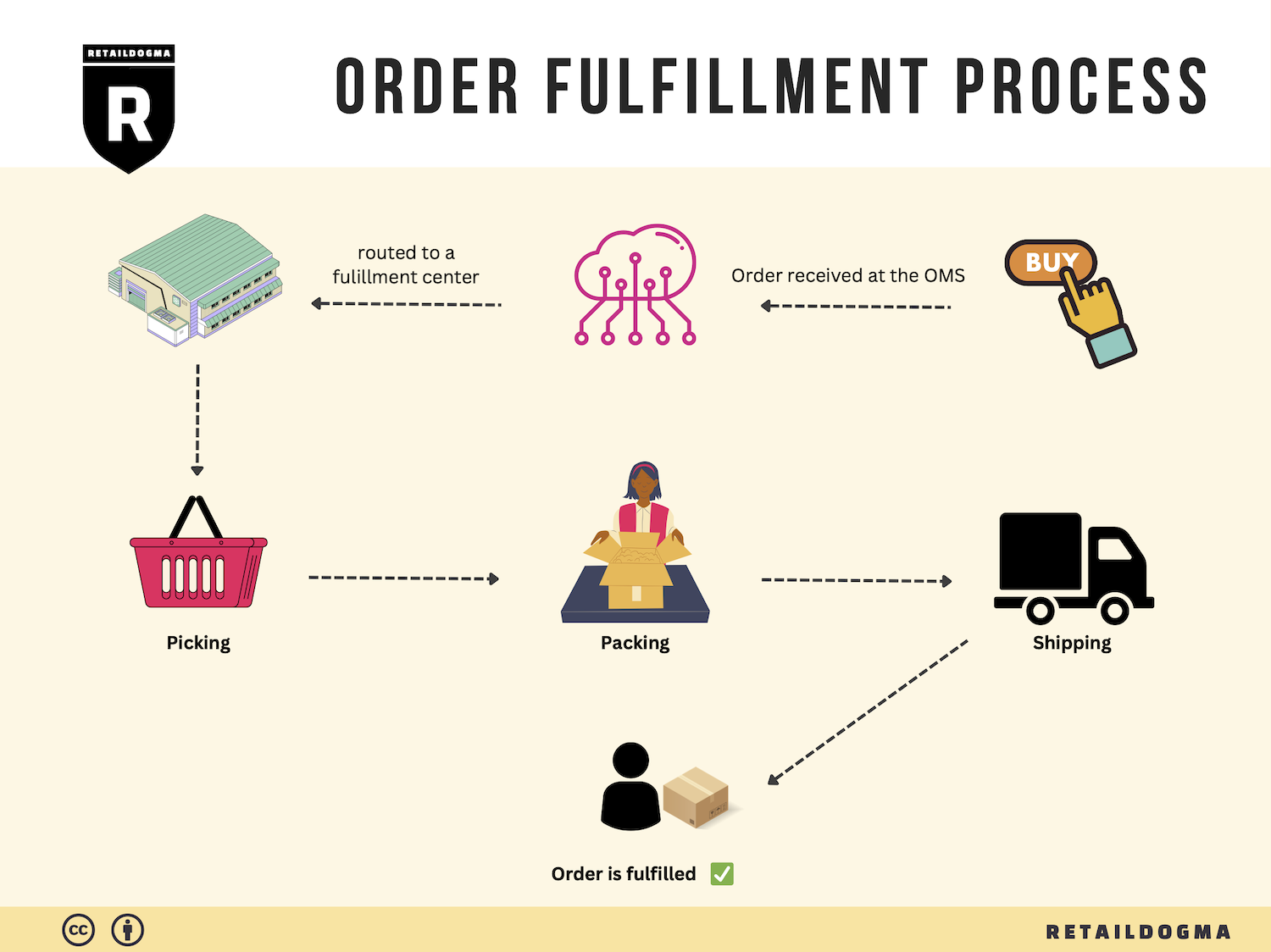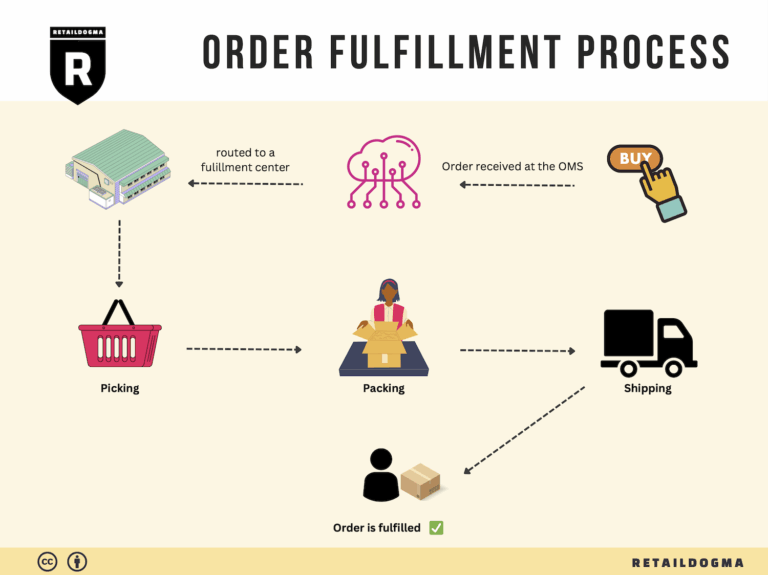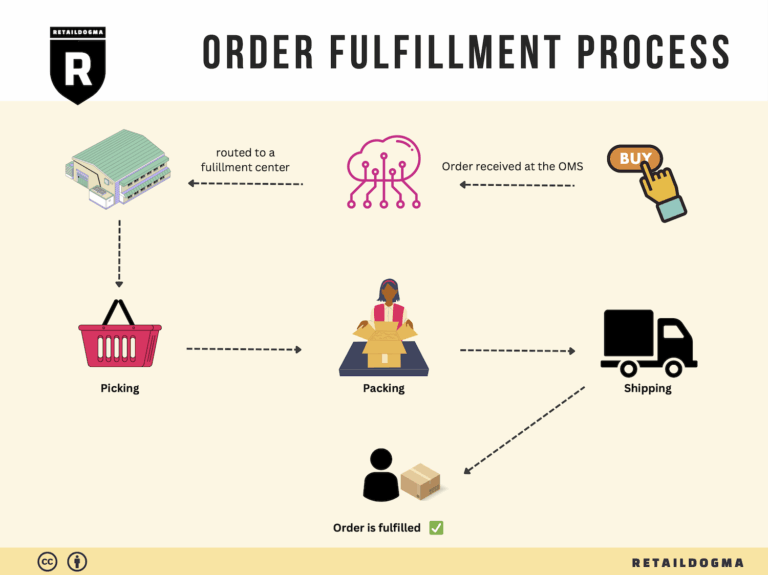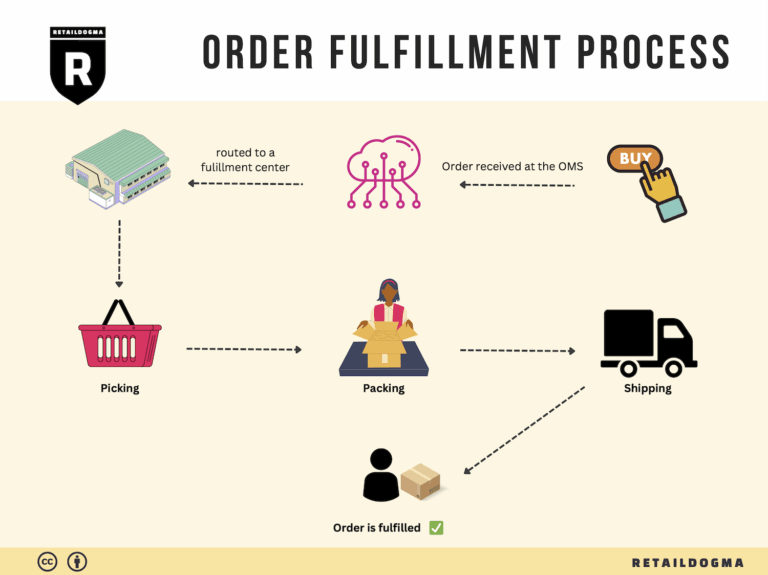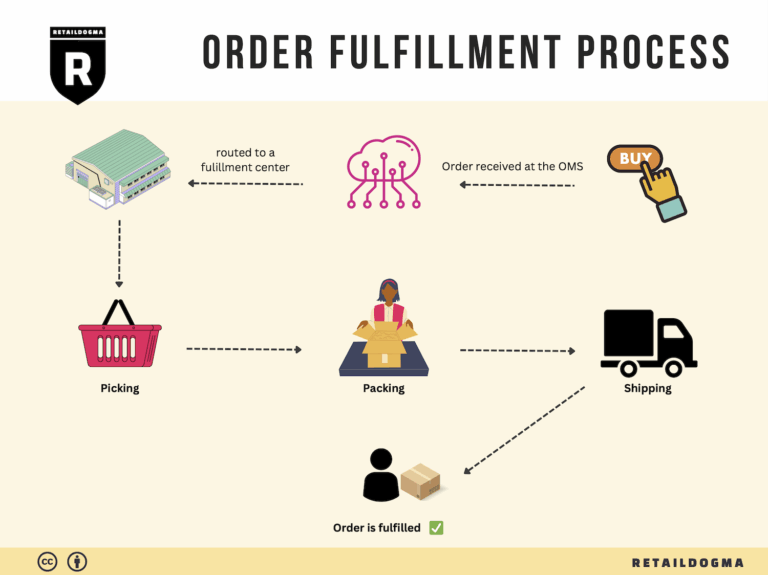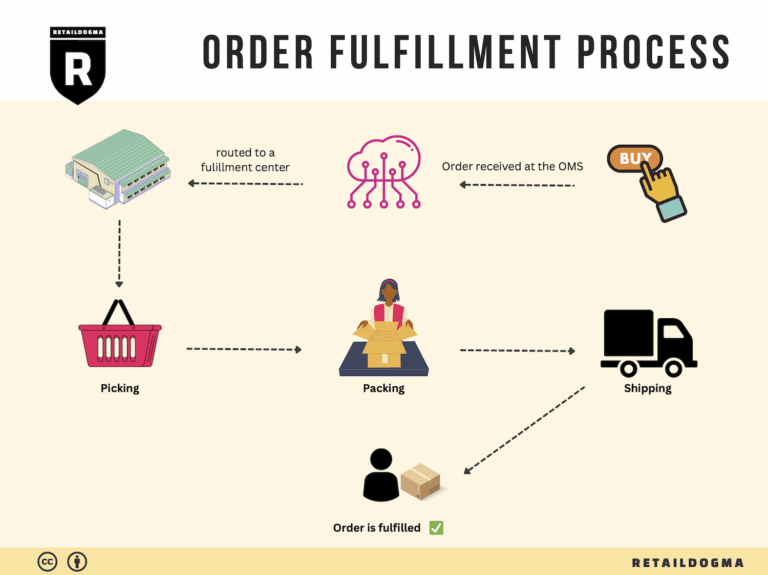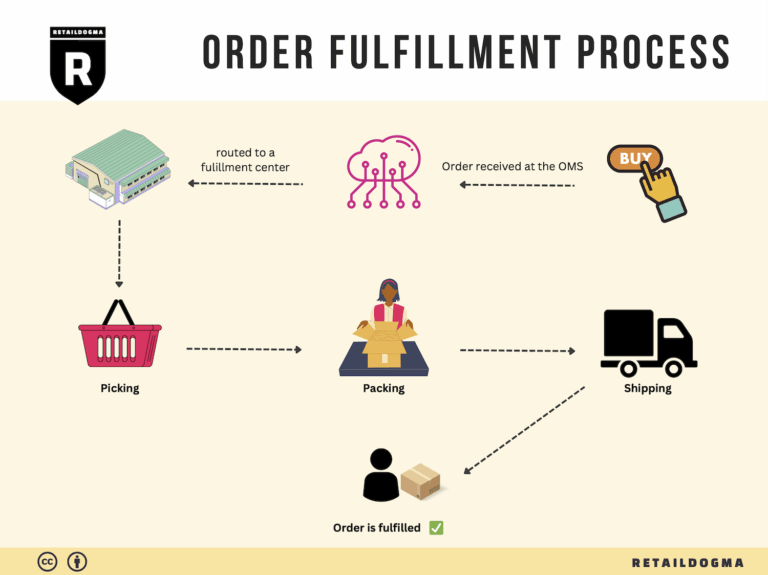Ecommerce Fulfillment Services: The Ultimate Guide (2025)
What is E-commerce Fulfillment? An Introduction for Growing Businesses
Understanding E-commerce Fulfillment
As an e-commerce business owner, you may find yourself overwhelmed with the logistics of packing and shipping orders. This common pain point can lead to stress and inefficiency, diverting your focus from growing your business. In essence, e-commerce fulfillment is the process of getting a product from your inventory to your customer’s doorstep. It encompasses everything from receiving and storing inventory to processing orders, packing products, and managing shipping.
In this guide, we will delve into the different fulfillment models available to growing businesses. You’ll learn about Third-Party Logistics (3PL) providers, which allow you to outsource your fulfillment operations, and Fulfillment by Amazon (FBA), a service that leverages Amazon’s extensive logistics network. Each model has its own advantages and can be tailored to fit your specific needs, whether you’re just starting out or scaling up.
We will also explore the core services that fulfillment partners typically offer. These include inventory management, order processing, packing, shipping, and returns handling. Understanding these services will help you identify what you need from a fulfillment partner and how to integrate those services into your existing operations.
Choosing the right fulfillment partner can be daunting. Factors such as location, technology, scalability, and customer service should all play a critical role in your decision-making process. We will provide a framework to help you evaluate potential partners, ensuring that you select one that aligns with your business goals and can grow alongside you.
Pricing is another crucial aspect of fulfillment. We will break down the various pricing structures you might encounter, including per-order fees, storage fees, and shipping costs. By understanding these costs, you can better forecast your expenses and make informed decisions that will positively impact your bottom line.
Ultimately, this guide aims to empower you to make smart, informed decisions about your logistics strategy. By mastering the complexities of e-commerce fulfillment, you can streamline your operations, enhance customer satisfaction, and focus on what truly matters—growing your business.
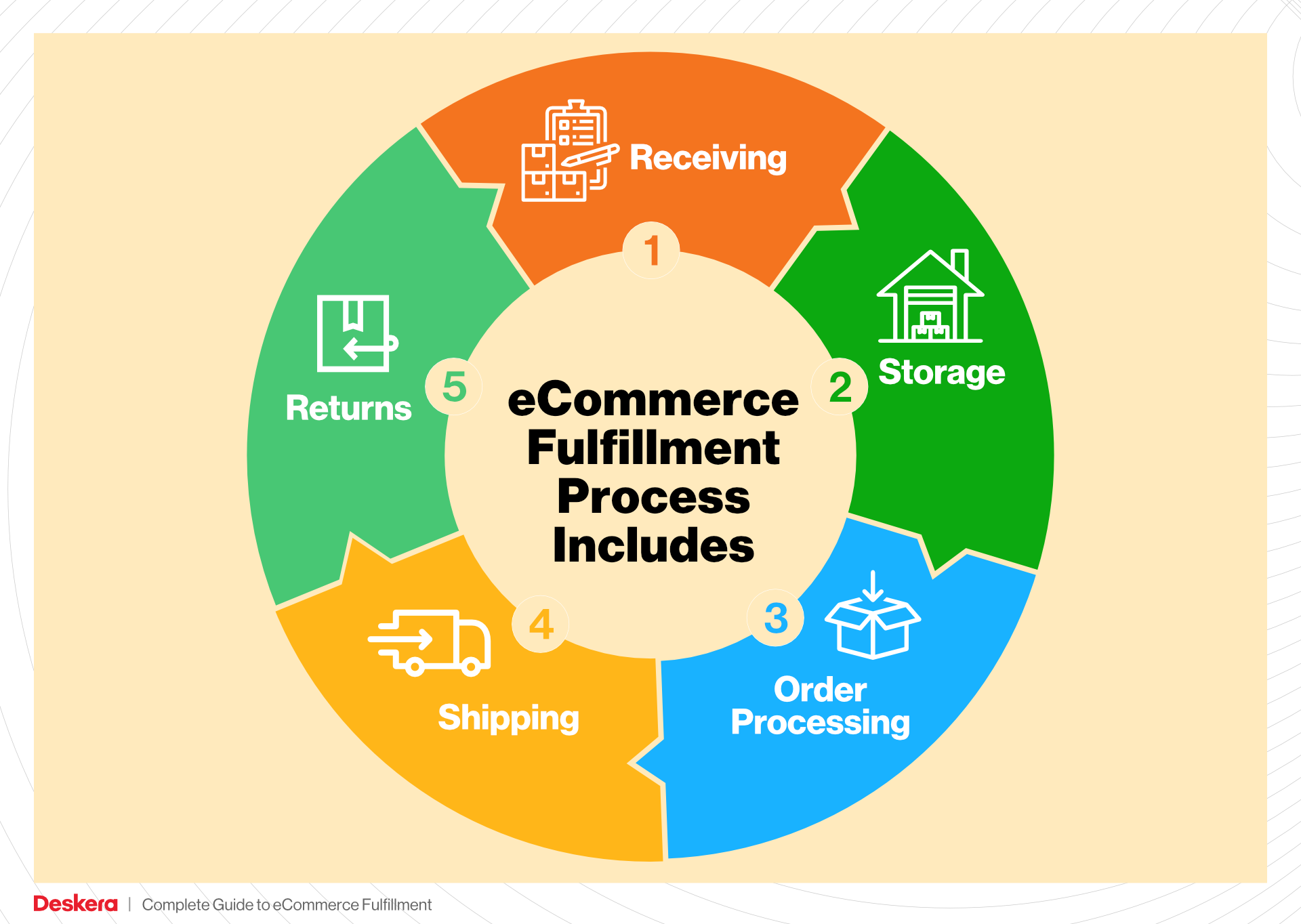
What You’ll Learn In This Guide
- What is E-commerce Fulfillment? An Introduction for Growing Businesses
- The Order Fulfillment Process: From ‘Buy’ Button to Customer’s Door
- Comparing Fulfillment Models: In-House vs. 3PL vs. Dropshipping
- A Deep Dive into Amazon FBA: Pros, Cons, and Who It’s For
- Core Services Offered by Fulfillment Centers
- How to Choose a Fulfillment Partner: A 6-Point Checklist
- Understanding Fulfillment Pricing: A Breakdown of Common Fees
- Frequently Asked Questions (FAQs) about Fulfillment
- Conclusion: Is Outsourcing Fulfillment the Right Move for Your Business?
- Important Disclaimer
The Order Fulfillment Process: From ‘Buy’ Button to Customer’s Door
1. Receiving Inventory
The first step in the order fulfillment process is receiving inventory. This involves accepting shipments of products from suppliers or manufacturers and checking them against purchase orders to ensure accuracy. During this phase, each item is logged into the inventory management system, often using Stock Keeping Units (SKUs) to track individual products. This is crucial because accurate receiving establishes the foundation for effective inventory management, which directly impacts order fulfillment speed and accuracy.
A key term associated with this step is SKU (Stock Keeping Unit), a unique identifier for each product that simplifies tracking and inventory management. Proper receiving processes help prevent stock discrepancies, minimize returns due to incorrect shipments, and ensure that the right quantities are available for customer orders.
2. Warehouse Storage
Once inventory is received, the next step is warehouse storage. This involves organizing and storing products in designated areas within the warehouse. Effective warehouse layout and storage systems are vital for optimizing space and facilitating quick access to items when orders are placed. Items are typically stored in a manner that considers their size, weight, and frequency of sales, ensuring that the most popular products are easily accessible.
The importance of this step lies in its impact on order picking efficiency. A well-organized warehouse reduces the time needed to locate items, ultimately speeding up the fulfillment process. A key term here is ABC analysis, which categorizes inventory based on importance and turnover rates, allowing businesses to prioritize storage locations for high-demand products.
3. Order Picking
Order picking is the process of retrieving items from their storage locations to fulfill customer orders. This step can be executed manually or through automated systems, depending on the scale and sophistication of the operation. Order pickers use pick lists, which detail the items and quantities required for each order, ensuring accuracy in fulfillment.
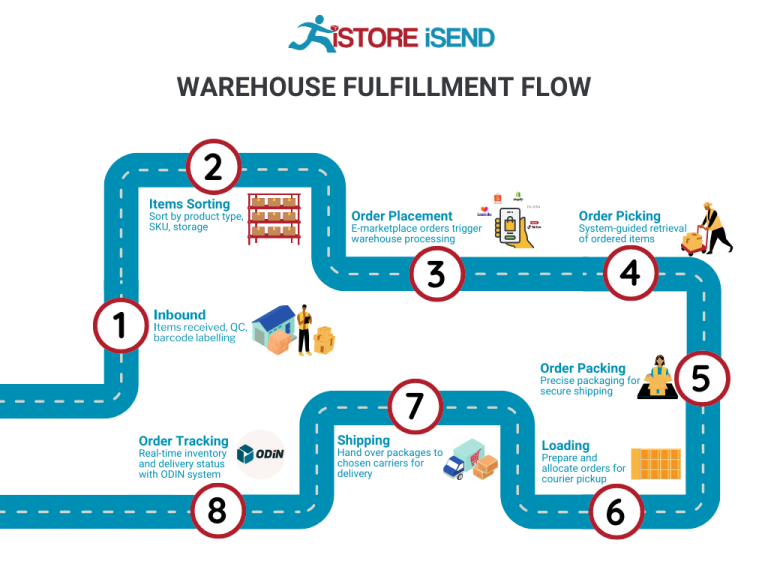
The significance of this step cannot be overstated; efficient order picking directly influences customer satisfaction and operational costs. Delays or inaccuracies in picking can lead to backorders, customer complaints, and increased shipping costs. A common method employed in this phase is batch picking, where multiple orders are picked simultaneously, enhancing efficiency and reducing travel time within the warehouse.
4. Order Packing
After items are picked, they must be packed for shipping. This step involves securely placing the items into boxes or containers, often with protective materials to prevent damage during transit. Effective packing not only protects the products but also optimizes shipping costs by minimizing dimensional weight.
The importance of packing lies in its role in enhancing the customer experience. A well-packed order reflects professionalism and care, which can lead to repeat business and positive reviews. A key term associated with this step is dimensional weight pricing, a shipping cost calculation method that considers both the weight and size of packages, underscoring the need for efficient packing practices.
5. Shipping & Delivery
The final step in the order fulfillment process is shipping and delivery. Once packed, orders are scheduled for shipment using various carriers, depending on customer preferences and cost considerations. This phase involves generating shipping labels, tracking information, and ensuring that the order is dispatched within the promised timeframe.
The importance of this step lies in its direct impact on customer satisfaction and brand loyalty. Timely delivery is often a critical factor in customer retention, and delays can lead to dissatisfaction. A key term in this context is last-mile delivery, which refers to the final leg of the shipping process where products are delivered from a transportation hub to the end customer. Effective management of last-mile delivery is essential for optimizing fulfillment operations and enhancing the customer experience.
By understanding and optimizing each of these five steps in the order fulfillment process, e-commerce businesses can improve their operational efficiency, reduce costs, and ultimately enhance customer satisfaction. As businesses scale, investing in robust systems and processes for each step becomes increasingly important to meet the demands of a growing customer base.
Comparing Fulfillment Models: In-House vs. 3PL vs. Dropshipping
Fulfillment Model Comparison
| Model | Who Handles Inventory | Best For (Business Stage) | Key Advantage | Key Disadvantage |
|---|---|---|---|---|
| In-House Fulfillment | Business Owns Inventory | Startups to Established | Greater control over operations | High upfront costs and risks |
| Third-Party Logistics (3PL) | 3PL Provider | Growing to Established | Scalability and expertise | Less control over inventory |
| Dropshipping | Supplier | Startups and Small Businesses | Low overhead and risk | Lower profit margins and reliability issues |
In-House Fulfillment
In-house fulfillment refers to a model where a business manages its own inventory and order fulfillment processes. This typically involves maintaining a warehouse or storage space, staffing it with employees (such as Order Fulfillment Associates), and utilizing a logistics system to handle orders. In-house fulfillment is particularly beneficial for businesses that have reached a certain level of stability and sales volume, as it allows for greater control over inventory, quality assurance, and customer service. By directly managing the fulfillment process, businesses can tailor their operations to meet specific customer needs, ensuring timely delivery and product condition. However, this model can also involve significant upfront costs, including warehousing expenses, staffing, and equipment investments. Moreover, businesses bear the risks associated with inventory management, such as overstocking or stockouts.
Third-Party Logistics (3PL)
Third-party logistics (3PL) is a fulfillment model where a business outsources its logistics operations to an external provider. The 3PL company handles inventory storage, order processing, and shipping on behalf of the business. This model is ideal for growing businesses that require flexibility and scalability without the burden of managing their own fulfillment infrastructure. By leveraging the expertise and technology of a 3PL provider, businesses can streamline their operations, reduce shipping costs, and improve delivery times. A key advantage of 3PL is the ability to scale operations quickly in response to market demand, allowing businesses to focus on core competencies such as product development and marketing. However, a significant drawback is the loss of control over inventory management and fulfillment processes, which can lead to discrepancies in order accuracy and customer satisfaction if the 3PL provider does not meet expectations.
Dropshipping
Dropshipping is a fulfillment model where a business sells products without holding any inventory. Instead, when a customer places an order, the business purchases the item from a third-party supplier who ships it directly to the customer. This model is particularly appealing for startups and small businesses due to its low overhead and minimal risk. Since there is no need to invest in inventory upfront, businesses can test new products and markets with greater agility. Additionally, dropshipping allows entrepreneurs to focus on marketing and sales rather than logistics. However, the dropshipping model has its challenges, including lower profit margins due to reliance on suppliers and potential issues with reliability and product quality. Since the business does not handle the product directly, any shipping delays or errors from the supplier can lead to customer dissatisfaction, which ultimately affects the business’s reputation.
Conclusion
Choosing the right fulfillment model is critical for e-commerce businesses looking to scale. In-house fulfillment offers control and customization but comes with higher costs and risks. Third-party logistics (3PL) provides a scalable solution with expert support but may compromise control over inventory. Dropshipping allows for a low-risk entry into e-commerce but can lead to lower profits and dependency on suppliers. Ultimately, the decision should align with the business’s goals, resources, and growth trajectory, ensuring a fulfillment strategy that supports sustained success.
A Deep Dive into Amazon FBA: Pros, Cons, and Who It’s For
Understanding Fulfillment by Amazon (FBA)
Fulfillment by Amazon (FBA) is a service provided by Amazon that allows e-commerce sellers to store their products in Amazon’s fulfillment centers. Amazon takes care of storage, packaging, shipping, and customer service, enabling sellers to focus on other aspects of their business. When a customer orders a product, Amazon picks, packs, and ships it directly to the customer, while also managing returns and customer inquiries. This service is particularly appealing for businesses looking to leverage Amazon’s extensive logistics network and customer base.
How FBA Works
-
Setup and Listing: Sellers sign up for an Amazon seller account and choose the FBA option. They create product listings and decide which items to send to Amazon’s fulfillment centers.
-
Shipping Inventory: Sellers ship their products to Amazon’s warehouses. They can send inventory in bulk or on a more frequent basis, depending on their sales velocity and storage fees.
-
Storage and Management: Once products arrive, Amazon takes responsibility for storing the inventory. Sellers can track their inventory levels through the Amazon Seller Central dashboard.
-
Order Processing: When a customer places an order, Amazon automatically picks the product from the warehouse, packs it, and ships it, often within one day. Customers benefit from Amazon’s fast shipping options, including same-day and two-day delivery.
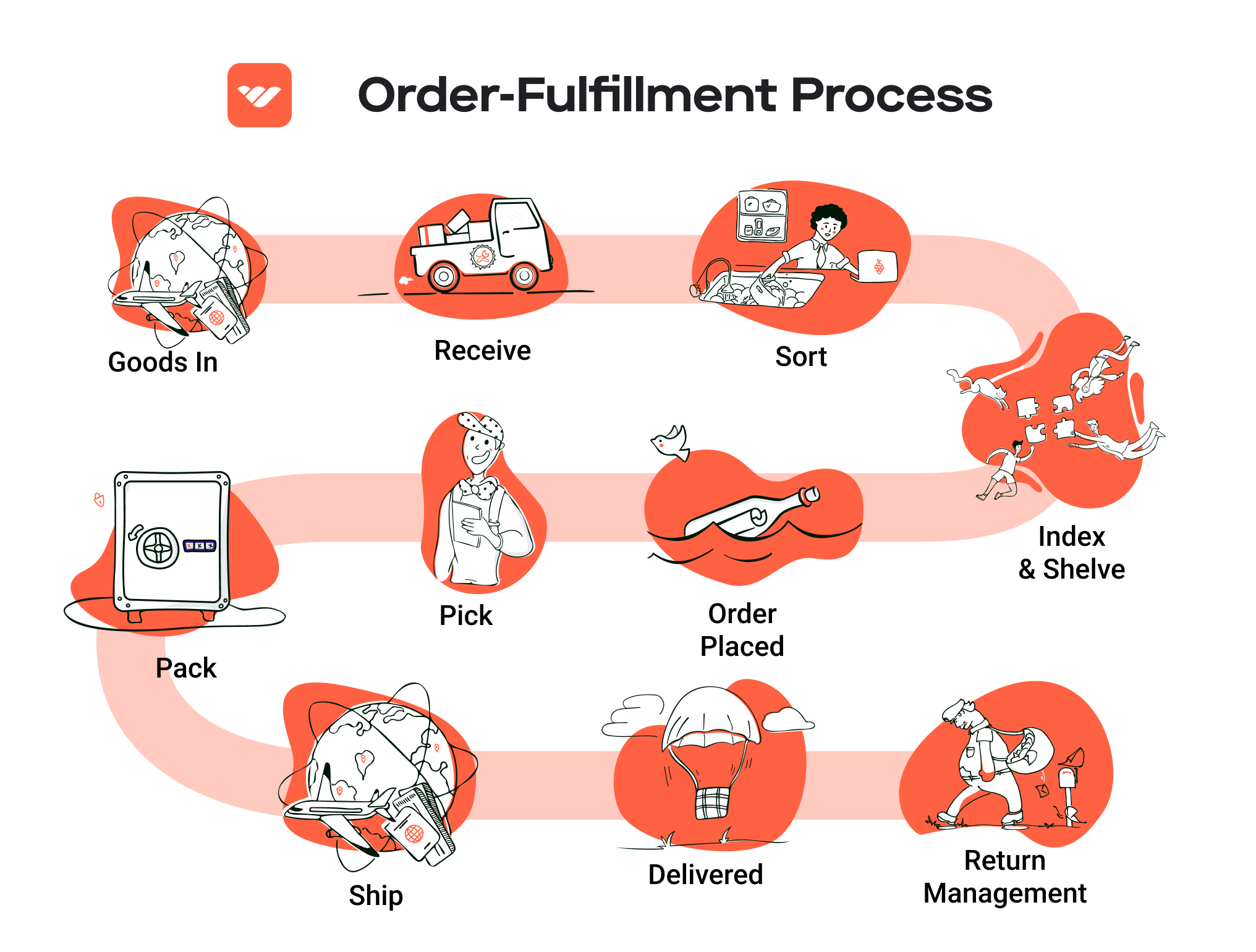
-
Customer Service and Returns: Amazon handles all customer service inquiries and returns for FBA products, which can significantly reduce the operational burden on sellers.
Pros of Fulfillment by Amazon (FBA)
-
Prime Eligibility: One of the most significant advantages of using FBA is that products become eligible for Amazon Prime. This increases visibility and attractiveness to Prime members who prioritize fast shipping, leading to higher sales potential.
-
Increased Customer Trust: Products fulfilled by Amazon often carry a perception of quality and reliability. Customers trust Amazon’s handling of their orders, which can lead to increased conversion rates for FBA sellers.
-
Multi-Channel Fulfillment: FBA allows sellers to fulfill orders from other sales channels (like their own website or eBay) through Amazon’s logistics network. This can streamline operations and enhance shipping efficiency.
-
Scalability: FBA enables sellers to scale their businesses without the need for significant investment in warehousing or logistics. As demand grows, sellers can easily send more inventory to Amazon without worrying about storage or staffing.
-
Robust Analytics: Amazon provides sellers with detailed analytics and reports that can help optimize inventory management and sales strategies, offering insights into customer behavior and sales trends.
Cons of Fulfillment by Amazon (FBA)
-
High Fees: FBA involves various fees, including storage fees for inventory and fulfillment fees for each order. These costs can add up, particularly for sellers with lower-priced items or slow-moving inventory.
-
Strict Inventory Rules: Amazon has stringent guidelines regarding inventory management, packaging, and labeling. Failure to comply with these rules can result in additional fees or penalties, making it essential for sellers to stay informed and organized.
-
Commingling Risks: FBA uses a commingling system, meaning that products from different sellers can be stored together. This can lead to potential issues with product quality and authenticity, as sellers may receive returns for items they did not sell.
-
Loss of Control: When using FBA, sellers relinquish a degree of control over their inventory and shipping processes. While this can simplify operations, it also means that sellers must rely on Amazon’s systems and policies, which can change without notice.
-
Limited Customization: FBA does not allow for much customization in packaging or branding. This may be a disadvantage for businesses that want to create a unique unboxing experience for their customers.
Who is FBA Best For?
Fulfillment by Amazon is particularly beneficial for:
-
Small to Medium-Sized Businesses: Companies that lack the infrastructure to manage their own fulfillment can leverage Amazon’s extensive logistics capabilities.
-
E-commerce Entrepreneurs: New sellers who want to tap into Amazon’s vast customer base without the complexities of order fulfillment can find FBA an attractive option.
-
Sellers with High Sales Velocity: Businesses that experience high sales volumes can benefit from the efficiency and scalability of FBA, allowing them to focus on growing their brand.
-
Retailers Looking to Expand: Established businesses wanting to enter the Amazon marketplace can use FBA to simplify logistics and reach new customers quickly.
-
Multi-Channel Sellers: Those selling on multiple platforms can use FBA to streamline their fulfillment processes, ensuring consistent and reliable delivery regardless of where the sale occurs.
In conclusion, Fulfillment by Amazon can be a powerful tool for e-commerce businesses looking to streamline operations, enhance customer trust, and scale effectively. However, it is essential for sellers to weigh the pros and cons and consider their specific business needs before diving into FBA. Understanding the intricacies of the program can help businesses maximize their potential while mitigating risks.
Core Services Offered by Fulfillment Centers
Inventory Management & Warehousing
Inventory management and warehousing are foundational services provided by fulfillment centers. This involves the systematic tracking and control of stock levels, storage, and distribution of products. Fulfillment centers employ advanced inventory management systems that utilize real-time data to monitor stock levels, forecast demand, and automate reordering processes. This ensures that e-commerce businesses maintain optimal inventory levels, reducing the risk of stockouts or overstock situations.
The benefits of effective inventory management are multifaceted. Firstly, it enhances operational efficiency by minimizing the time and resources spent on manual inventory checks and reconciliations. Secondly, accurate inventory tracking allows businesses to make informed purchasing decisions, ultimately leading to better cash flow management. Moreover, it improves customer satisfaction by ensuring that products are readily available for prompt shipping, thereby enhancing the overall shopping experience. For e-commerce businesses looking to scale, robust inventory management systems are critical in supporting growth and meeting customer expectations.
Pick and Pack Services
Pick and pack services are a core function of fulfillment centers, where products are selected (picked) from the warehouse shelves and packed for shipment to customers. This process is typically executed using automated systems and skilled labor to ensure accuracy and efficiency. Fulfillment centers utilize sophisticated software that integrates with e-commerce platforms to streamline order processing, enabling quick and accurate fulfillment of customer orders.
The primary benefit of pick and pack services is the speed and accuracy with which orders are fulfilled. In today’s fast-paced e-commerce environment, customers expect rapid delivery. By outsourcing this function to a fulfillment center, businesses can significantly reduce order processing times, allowing them to compete effectively in the market. Additionally, fulfillment centers often employ quality control measures during the packing process to minimize errors and returns, further enhancing customer satisfaction. For e-commerce businesses aiming to scale, efficient pick and pack services are essential for sustaining growth and maintaining a competitive edge.
Kitting and Assembly
Kitting and assembly services involve the grouping of multiple products into a single package or the assembly of components into a finished product. This service is particularly beneficial for e-commerce businesses that offer bundled products or customizable kits. Fulfillment centers can handle the complexities of assembling these kits, ensuring that all components are included and correctly packaged.
The benefit of kitting and assembly services lies in their ability to enhance product offerings and improve operational efficiency. By offering bundled products, e-commerce businesses can increase average order values and provide customers with a more convenient shopping experience. Furthermore, outsourcing kitting and assembly to a fulfillment center allows businesses to focus on core activities such as marketing and customer service, rather than the logistics of product assembly. This strategic advantage can be pivotal for scaling businesses as they seek to diversify their product lines and enhance customer engagement.
Returns Management (Reverse Logistics)
Returns management, or reverse logistics, is a critical service provided by fulfillment centers that handles the process of returned goods. This includes receiving returned items, inspecting their condition, restocking them if they are in sellable condition, or managing their disposition if they are not. Effective returns management is essential for maintaining customer satisfaction and loyalty, as a hassle-free return process can significantly influence a customer’s perception of a brand.
The benefits of robust returns management are substantial. Firstly, it helps e-commerce businesses recover value from returned products, either through restocking or refurbishment. Secondly, a streamlined returns process can enhance customer trust and encourage repeat purchases, as customers are more likely to shop from a retailer that offers an easy return experience. Additionally, data collected during the returns process can provide valuable insights into product performance and customer preferences, enabling businesses to make informed decisions about inventory and product offerings. For scaling e-commerce businesses, effective returns management is not just a cost center; it is a strategic asset that can drive customer loyalty and operational efficiency.
In summary, fulfillment centers provide a suite of core services that are essential for the success of e-commerce businesses. By leveraging these services—inventory management and warehousing, pick and pack, kitting and assembly, and returns management—businesses can enhance their operational efficiencies, improve customer satisfaction, and scale effectively in a competitive marketplace.
How to Choose a Fulfillment Partner: A 6-Point Checklist
Location & Warehouse Network
Choosing a fulfillment partner with strategically located warehouses is critical for efficient logistics. Proximity to your customer base can significantly reduce shipping times and costs, enhancing customer satisfaction.
Questions to Ask:
– Where are the fulfillment centers located, and how do these locations align with my primary customer demographics?
– What is the average shipping time from their warehouses to my customers?
– Do they have a network of warehouses that can accommodate seasonal fluctuations in demand?
Technology & Integrations
In today’s digital marketplace, seamless technology integration is essential for effective order management, inventory tracking, and customer communication. Your fulfillment partner should have a robust technology platform that can integrate with your existing e-commerce systems.
Questions to Ask:
– What technology do you use for inventory management, and how real-time is the data?
– Can your system integrate with my e-commerce platform (e.g., Shopify, WooCommerce)?
– What reporting capabilities do you offer, and how can I access insights into order performance and inventory levels?
Specializations
Depending on your product line, you may require a fulfillment partner that specializes in certain areas, such as cold storage for perishables or handling oversized items. A partner with the right expertise can ensure that your products are stored and shipped under optimal conditions.
Questions to Ask:
– What types of products do you specialize in handling?
– Do you have any certifications or compliance measures in place for specific product categories (e.g., food safety, hazardous materials)?
– How do you handle special packaging requirements for fragile or oversized items?
Scalability & Capacity
As your business grows, your fulfillment partner must be able to scale operations to meet increasing demand. Assessing their capacity to handle fluctuations in order volume is crucial to maintaining service levels during peak seasons.
Questions to Ask:
– What is your current capacity for order fulfillment, and how do you plan to scale as demand increases?
– Can you accommodate seasonal spikes in order volume? If so, how?
– What is your process for managing excess inventory during off-peak seasons?
Pricing and Contracts
Understanding the pricing structure and contract terms is essential to avoid unexpected costs that could impact your bottom line. Look for transparency in pricing and flexibility in contract terms that can adapt to your business needs.
Questions to Ask:
– What are your pricing models (e.g., per order, per item, monthly fees), and what do these include?
– Are there any hidden fees (e.g., for storage, returns, packaging)?
– What are the contract terms regarding cancellation, service level agreements, and penalties for unmet performance metrics?
Customer Support & Reviews
A reliable fulfillment partner should offer strong customer support and have a good reputation in the industry. Excellent customer service can help resolve issues quickly, minimizing disruptions to your business.
Questions to Ask:
– What customer support channels do you offer (e.g., phone, email, chat), and what are your response times?
– Can you provide references or case studies from other clients in my industry?
– How do you handle order errors or customer complaints, and what is your process for resolving issues?
Conclusion
Choosing the right fulfillment partner can significantly impact your e-commerce operations and customer satisfaction. By carefully assessing these six key areas—location, technology, specializations, scalability, pricing, and customer support—you can make an informed decision that aligns with your business goals and growth trajectory. Always remember to conduct thorough due diligence and consider multiple partners before making a commitment. This approach will not only help you find the best fit but also build a foundation for a successful long-term partnership.
Understanding Fulfillment Pricing: A Breakdown of Common Fees
Initial Setup Fees
Initial setup fees are one-time charges incurred when establishing a relationship with a fulfillment provider. These fees cover the costs associated with onboarding, which can include account setup, system integration, and training your staff on the fulfillment process. The fee structure can vary widely among providers, typically ranging from a few hundred to several thousand dollars, depending on the complexity of your needs and the technology involved.
To calculate your initial setup fee, ask potential providers about their onboarding process and any associated costs. Some may offer tiered pricing based on the number of SKUs (Stock Keeping Units) you plan to store and fulfill, while others might charge a flat rate. It’s crucial to clarify what services are included in this fee to avoid unexpected costs later.
Receiving Fees
Receiving fees are charged when your inventory arrives at the fulfillment center. This fee covers the labor and resources required to unload, inspect, and enter inventory into the warehouse management system (WMS).
Receiving fees are generally calculated based on the volume of goods being received, often assessed per unit or per pallet. For instance, a provider may charge $0.50 to $2.00 per item or $5.00 to $25.00 per pallet, depending on the complexity of handling the items. To manage these costs effectively, ensure your shipments are organized and labeled correctly to minimize processing time at the facility.
Storage Fees (per pallet/bin)
Storage fees are ongoing charges for keeping your inventory in the fulfillment center. These fees can vary based on the size of your inventory and the duration for which items are stored. Providers typically charge storage fees on a monthly basis, calculated per pallet or bin.
For instance, monthly storage fees might range from $10 to $50 per pallet, depending on the provider and the location of their warehouse. Some providers may also offer tiered pricing based on the volume of storage you utilize—larger volumes may attract lower per-pallet rates. To optimize storage costs, consider implementing just-in-time inventory strategies to reduce the time items spend in storage.
Pick & Pack Fees (per item/order)
Pick and pack fees are incurred each time an order is processed. These fees cover the labor involved in selecting items from storage, packing them, and preparing them for shipment.
Pick and pack fees can vary significantly based on the complexity of the order. A common pricing model might charge $1.00 to $5.00 per order, plus an additional fee per item (e.g., $0.25 to $1.00 per item). For businesses with a high volume of small orders, these fees can add up quickly. To minimize these costs, consider bulk packaging or consolidating orders when possible, which can reduce the number of individual pick and pack operations.
Shipping Fees
Shipping fees represent the costs associated with transporting your orders to customers. These fees can be influenced by several factors, including the size and weight of the package, the shipping method selected (standard, expedited, etc.), and the distance to the delivery address.
Shipping costs can be calculated based on either flat rates or variable rates that fluctuate depending on the specifics of each shipment. Many fulfillment providers will have partnerships with major carriers to offer discounted shipping rates, which can help lower costs. It’s essential to understand the shipping options available and consider offering multiple shipping methods to cater to different customer preferences.
Tips for Getting an Accurate Quote
-
Be Specific: When requesting quotes, provide detailed information about your business needs, including estimated order volumes, types of products, and any special handling requirements.
-
Understand the Fee Structure: Ask potential providers to break down their pricing models. Understanding how each fee is calculated will help you compare different providers effectively.
-
Inquire About Discounts: Some providers may offer discounts for high volumes or long-term contracts. Be sure to ask about any available incentives.
-
Consider Total Costs: Look beyond the initial setup and storage fees. Evaluate the total cost of fulfillment, including shipping, pick and pack, and any potential surcharges.
-
Request Case Studies: Ask for examples from similar businesses that have used the provider’s services. This can give you insights into potential hidden costs and overall satisfaction with the service.
By understanding these common fulfillment pricing models and asking the right questions, you can make an informed decision that supports your business’s growth and efficiency.
Frequently Asked Questions (FAQs) about Fulfillment
1. What are the primary responsibilities of an Order Fulfillment Associate at Home Depot?
Order Fulfillment Associates (OFAs) are mainly tasked with retrieving products from shelves and setting them aside for customers who have placed online orders. Their role is crucial in ensuring that orders are processed efficiently and accurately, contributing to customer satisfaction.
2. Do Order Fulfillment Associates need to perform heavy lifting?
Yes, OFAs should expect to lift and move products as part of their daily responsibilities. This may involve handling items that can vary in weight and size, so physical capability is an important aspect of the role.
3. How much customer interaction does an Order Fulfillment Associate have?
While the majority of an OFA’s work is conducted away from direct customer interaction, there are instances where they may need to assist customers, particularly if questions arise regarding their orders or products.
4. What is the typical work schedule for an Order Fulfillment Associate?
Order Fulfillment Associates usually have consistent work schedules, with morning, afternoon, and evening shifts available. Schedules are typically communicated in advance, allowing associates to plan their time outside of work effectively.
5. Is prior knowledge of product locations necessary for the job?
No prior knowledge is required. Home Depot provides tools and resources to help OFAs learn the layout of the store and locate products efficiently. This training is essential for new associates to quickly become adept at fulfilling orders.
6. What is the difference between a warehouse and a fulfillment center?
A warehouse is primarily used for storage, while a fulfillment center is designed to process and ship orders directly to customers. Fulfillment centers focus on efficient order processing, packing, and shipping, often incorporating advanced technology for inventory management.
7. What is a Third-Party Logistics Provider (3PL)?
A Third-Party Logistics Provider (3PL) is a service that allows businesses to outsource their logistics and fulfillment operations. This can include warehousing, inventory management, order processing, and shipping. Utilizing a 3PL can help businesses scale their operations without the need for significant investment in infrastructure.
8. How much do fulfillment services typically cost?
Costs for fulfillment services can vary widely based on factors such as the volume of orders, the complexity of the fulfillment process, and the specific services required. On average, businesses may expect to pay anywhere from $2 to $5 per order for basic fulfillment services, with additional charges for storage, packaging, and shipping.
9. What skills are beneficial for an Order Fulfillment Associate?
Key skills for an OFA include attention to detail, organizational abilities, and basic physical fitness. Familiarity with inventory management systems and a customer-oriented mindset can also enhance performance in this role.
10. What are the career advancement opportunities for Order Fulfillment Associates at Home Depot?
Home Depot provides various career growth paths for OFAs, including positions such as Assistant Store Manager, Area Supervisor, and Service Desk Supervisor. Opportunities for advancement often depend on performance, experience, and the willingness to take on additional responsibilities.
Conclusion: Is Outsourcing Fulfillment the Right Move for Your Business?
Evaluating the Benefits of Outsourcing Fulfillment
Outsourcing your order fulfillment can be a strategic move that offers significant advantages for your e-commerce business. One of the most immediate benefits is time savings. By leveraging a fulfillment partner, you can redirect your focus from daily logistics to core business activities such as marketing, product development, and customer engagement. This shift allows you to enhance your overall operational efficiency and drive growth.
Scalability is another compelling reason to consider outsourcing. As your business expands, so do your fulfillment needs. A reliable fulfillment partner can easily adjust to fluctuations in order volume, ensuring that you can meet customer demand without the headache of managing additional warehouse space or labor. This flexibility is particularly crucial during peak seasons, where demand can surge unexpectedly.
Moreover, fulfillment services bring specialized expertise to the table. Many providers have established systems and processes designed to optimize shipping times and reduce costs. Their experience in logistics can lead to improved accuracy and reliability, ultimately enhancing customer satisfaction. By partnering with professionals who understand the nuances of fulfillment, you can leverage their knowledge to refine your own operational strategies.
However, it’s vital to choose the right fulfillment partner to align with your business goals. Conduct thorough research, assess potential partners based on their track record, technology capabilities, and customer service reputation.
As a strategic call-to-action, take a moment to audit your current shipping and fulfillment processes. Are there inefficiencies that could be addressed? Could your business benefit from the scalability and expertise of a fulfillment partner? Exploring these questions could lead you to the right solution, positioning your business for sustained growth and success in the competitive e-commerce landscape.
Important Disclaimer
⚠️ Important Disclaimer
The information in this guide is for educational purposes. Fulfillment services, pricing, and platform features change frequently. Always conduct your own due diligence and consult with providers directly before making business decisions.
